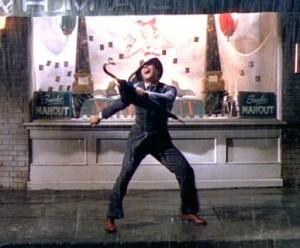Often when we talk about the art of game design a comparison with movies soon follows. It is not a surprise that the two are so frequently talked about in the same breath as many gamers have an interest in movies and they regularly share themes and ideas. Also, and perhaps more importantly to the wider audience, the media on which we view them is the same. Fortunately for this article the comparison is also a useful place from which to look at the evolution of games.
In truth the two forms of entertainment are very different, with the passive nature of film making the experience far easier for the author to sculpt a consistent narrative. The illusion is rarely stretched by the viewer, and no one deliberately tries to break the experience. But both media exist in a similar space in most people’s consciousness and there are frequent crossovers between the two. Usefully the two are also both very recent forms of entertainment and as such cinema proves a useful starting point from which to draw analogies to help us better visualise the phase of the development games are in.

If we look at cinema’s development (I am not a scholar here, just an enthusiast) we can view how the media progressed and was put to better use, both in the technology and its creative application. The very first examples of cinema were merely tech demos (for want of a better term), a proof of concept of what the medium could do. Upon seeing this new art form people were inspired. The lack of sound meant workarounds had to be used; on screen text helped to progress plot and live pianists (later gramophones) produced additional atmosphere for the filmgoer. Despite these limitations people started to produce comedies and romances, drawing heavily on classic storytelling methods. Even theatrical stage techniques (such as mime) were applied to great effect, producing a spellbinding magic for early audiences.
As engineers became more familiar with the technology and inspired by the work of directors they too were inspired to advance the medium. Sound and then colour came to movies offering more possibilities to creative storytellers. Still theatrical elements were applied, but suddenly location, camera tricks and special effect became used to great advantage. But it didn’t change the fact that for a long time the majority of movies were stage shows committed to screen. Closed sets and simple plots that could have been recreated in theaters. The movie musicals of the fifties are a prime example of this. Drawing heavily on the cabarets and stage musicals of the time, story was for the most part filler to the huge Technicolor set pieces that were the focus of the show.

Movies such as Citizen Kane (1941) left the crutch of theatre behind and formed a new narrative style for film. Utilizing the tools available director Orson Welles managed to take people on a journey that couldn’t have been created in any other entertainment media. This laid the groundwork for modern cinema, but it was still some time before it became more widely adopted. More recently movies like Memento managed to use the medium of film to contort the expectations of what a story could be, how flow could be manipulated to misdirect but not cheat us. Cinema is far from finished in its development but it has managed to craft a strong fundamental base to its art that will form the foundation moving forward.
Thanks to the age of their conception games have undergone an incredibly rapid advancement. The jumps seen in the thirty something years of gaming’s life would be the equivalent of the first seventy years or so of cinema, and in many ways with theatre to draw upon cinema had a head start. But gaming is not yet at a point where I feel we could fairly compare it to modern film masterpieces such as The Usual Suspects or A Clockwork Orange.

Developers are just now moving beyond the cinematic equivalent of the death of the musical. We have moved through the technological barriers which limited designer’s creativity and are just beginning to limp away from the crutch of the cinema. Hopefully soon game stories can be told without gameplay being a way to bridge the gap to the next plot element. Games are now able to start coming to terms with how the manipulation and interactivity they offer the audience makes them fundamentally different. This seems obvious but only recently have games stared breaking from a fairly basic sport or movie narrative structure (at least in terms of the underlying goal).
Indie/art games have been doing this for some time and recently their lead is starting to be followed by the mainstream. Ico managed to use the interaction with your computer ally to form a bond different from those experienced in movies. Without speech or heavy exposition the game manages through interaction alone to form an attachment. Action titles are also starting to apply the lessons learned through the evolution of the industry. Though the story is more cinematic in its pacing Call of Duty 4 manages to place you in the role of four characters during the course of its story. By virtue of the first person perspective the game was able to allow you to experience each character’s story. While many games utilise the first person to great effect, Call of Duty 4 created situations rarely effectively portrayed in either games or movies. By allowing the player to control characters who were powerless against their fate the game toyed with the audience’s expectations of empowerment. By doing this the developers (Infinity Ward) displayed an awareness of the medium that is only recently becoming part of mainstream gaming.

Games have come along way. Indeed I think everything that anything a designer could want to do in a game (at least in the form we recognise them in today) can now be done, technically at least. That isn’t to say that everything has been done, but the mechanics are in place to do them (excluding a huge leap within the field of AI). There are still advancements that will alter how we interact with games, but the ability is there to produce any world. Graphics and physics will continue to improve but the environment can be produced. Hopefully we are now at a point where our directors and our storytellers, can focus on the art of their craft, untied from the worries of what they are able to do, focusing instead on what they want to achieve.
If this generation of consoles last longer than previous ones (as some are anticipating) then this can only be a good thing for the art of game design. They will be freed from the pressure of relearning hardware and the expectation of pushing the visual fidelity. Developers will be free to learn how to best use the tools they have, pushing the medium in new and interesting directions rather than simply iterating on what has gone before.